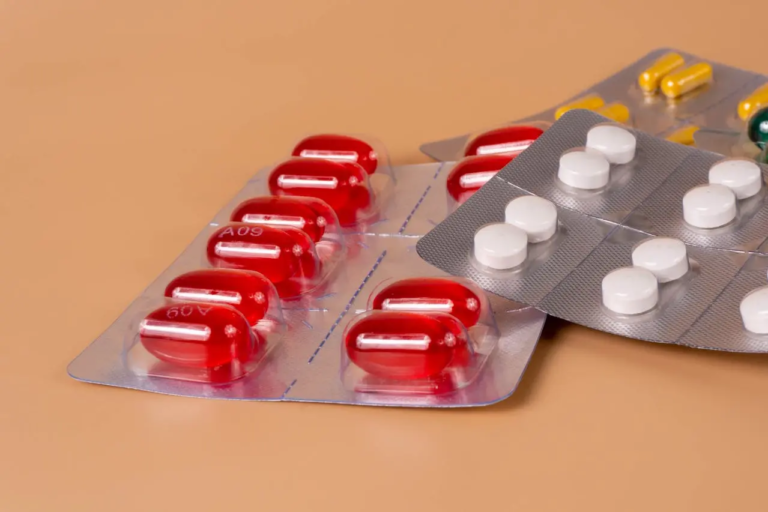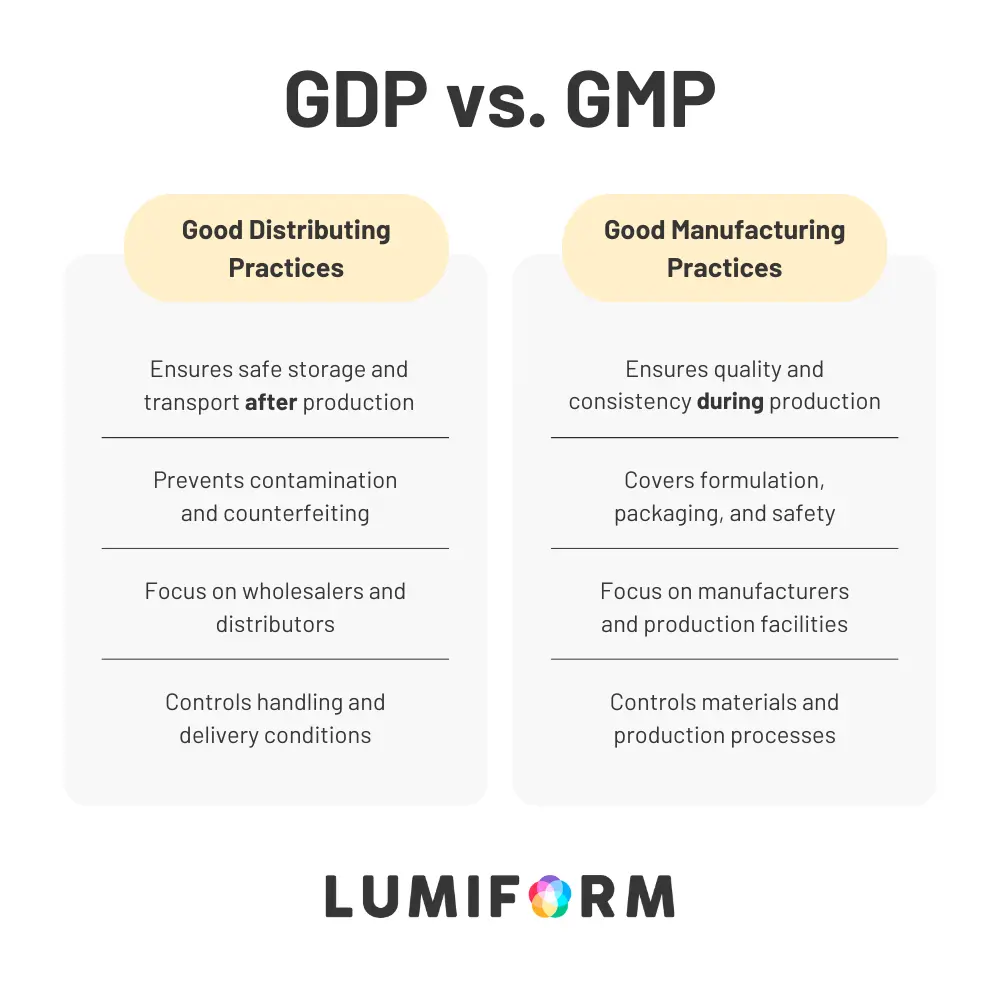Good distribution practices (GDP) offers a framework for making sure that organizations store, transport, and handle medicines under controlled conditions properly. These are critical for safety. By following GDP, you prevent risks to patient health by keeping medicines effective as they go from manufacturing to the end users.
This guide will give you a solid foundation on good distribution practices. We’ll go into its key components, from training staff and maintaining facilities to conducting regular audits. This gives you a high-level overview of what’s needed for compliance.
What is good distribution practice (GDP)?
Good distribution practices (GDP) are a set of guidelines for handling medicines safely and correctly as they move through the supply chain. From the time a medicine is made until it reaches a pharmacy or healthcare provider, it should be stored, transported, and tracked carefully. These guidelines cover practices like keeping medicines at the right temperature, protecting them from contamination, and using secure packaging that prevents tampering. The main goal of GDP is straightforward: to make sure that patients receive medicines that work as they should.
In the pharmaceutical industry, GDP is actually a requirement, not just a recommendation. The World Health Organization (WHO) has published the global standard for good distribution practices. Government agencies like the U.S. Food and Drug Administration (FDA) and European Medicines Agency (EMA) have also set GDP standards, conducting inspections of pharmaceutical supply chains to check for compliance.
What’s the difference between GDP and GMP?
You might also have heard of GMP, which is quite different–it stands for Good Manufacturing Practices (GMP).
Both of them are guidelines for pharmaceutical products, but they focus on different parts of the process. GMP applies to the manufacturing side, covering everything that happens while medicines are in production. With GMP, each medicine meets strict quality standards before it even leaves the manufacturing facility.
Once the medicine is finished and ready to be distributed, GDP then takes over. With GDP, medicines should stay in top condition until they reach the end user.
Here’s a summary of their differences:
Who needs to comply with GDP?
Anyone who’s involved in storing, handling, and transporting pharmaceutical products must comply with good distribution practices. This includes pharmaceutical manufacturers, wholesale distributors, logistics companies, and storage facilities–regardless of the country. Even third-party contractors who are hired for specific steps in the distribution process must follow GDP so product quality and safety are not compromised.
Each of these parties plays a role in the pharmaceutical supply chain:

Any weak link could affect the medicine reaching patients. For example, distributors need to maintain proper storage conditions, while logistics companies must protect products from being damaged or exposed to unsuitable environments.
Key standards for good distribution practices
The GDP guidelines set by WHO give a solid framework for maintaining medicine quality as it moves through the supply chain. Here’s a quick guide to the core GDP standards:
Quality management system (QMS)
A strong quality management system lies at the foundation of GDP compliance. There should be robust policies and processes so each stage of distribution maintains the integrity of the product. With a proper QMS, you can identify potential issues before they affect product quality. Different locations and teams should also have consistent standards so distribution is efficient. Document each part of the QMS for traceability and easy auditing, which is essential in the tightly regulated pharmaceutical industry.
Personnel training
All employees involved must know about GDP guidelines, and they must understand their role in safeguarding product quality. This training covers topics like:
- Hygiene standards
- Safe handling practices
- Emergency procedures
- Storage and environmental controls
- Security protocols
From the training, employees should know how to prevent products from getting contaminated or degrading. This isn’t one-time, either–they should also go through regular refresher training since this keeps everyone up-to-date with any changes in guidelines or procedures.
Premises and equipment standards
The premises and equipment used for distribution must meet strict standards. Storage facilities need controlled temperature and humidity so that medicines don’t degrade because of environmental factors. Regularly maintan and monitor equipment as well, like refrigeration units or automated storage systems. Other good practices include:
- Having proper security to prevent unauthorized access
- Storing products in a way that avoids damage, contaminations, or mix-ups
- Installing backup power sources for critical equipment so even during power outages, the quality of medicines isn’t affected
Documentation and record-keeping
With detailed, accurate documentation, every step in the distribution process is traceable–which is foundational to GDP compliance. There should be thorough records of the product’s handling history, from storage conditions and transportation to any actions taken by personnel along the way. Good documentation practices include consistently logging details like:
- Temperature readings and humidity levels
- Who accessed storage areas or handled the products
- Inventory movement
- Equipment maintenance
These records must be clear, accessible, and easy to retrieve, as inspections or audits may require them at any time.
Operations and inventory management
Operations and inventory management are also critical for good distribution practices. This way, you can handle products properly and keep them safe at every stage. Effective inventory management includes:
- Maintaining an organized storage system
- Regularly tracking stock levels
- Rotating products according to expiry dates
- Implementing processes to prevent overstocking
By keeping operations efficient, you minimize product. This reduces wear and tear or accidental exposure to harmful conditions.
Suppliers and distributors
Suppliers and distributors must all meet strict criteria for quality, reliability, and compliance, such as:
- Having robust quality management systems in place
- Having all the necessary licenses, permits, and registrations to operate legally
- Compliance with pharmaceutical regulations in their area
- Proof of being financially sound through their financial statements and credit history
Verifying these factors decreases risks of poor-quality products, delays, or mishandling. Companies must conduct thorough audits of suppliers and distributors and check their performance history. To make the process more thorough, you can use these distribution agreement form templates to set clear terms.
Risk management and incident reporting
Risk management includes evaluating areas where product safety could be compromised, like during transport or storage. Companies must conduct regular risk assessments for this so they can put preventive measures in place and make quality failures less likely. Hand-in-hand with this, there should also be an effective incident reporting system, where you can thoroughly document problems like temperature deviations or handling breaches. If these happen, take prompt action to resolve them and prevent them from happening again, with detailed records of each incident.
Product recall and return procedures
Product recall and return procedures ensure that you can remove any defective or potentially harmful products from the supply chain promptly. A strong recall process is crucial in the pharmaceutical industry, as even minor issues can pose health risks. Recall procedures should have clear steps for:
- Identifying the affected product, including the batch number
- Isolating the product to prevent distribution or usage
- Notifying the regulatory authorities
- Retrieving and collecting the product
Once products are returned, evaluate them to decide if you can restock, repurpose, or safely dispose of them.
Audit and continuous improvements
To maintain high GDP standards and adapt to changes in regulations, companies should commit to continuous improvements and go through audits regularly. These audits assess how effective GDP practices are across the supply chain. Audits might be internal–conducted by the company–or external, performed by regulatory bodies or third-party auditors. Both types are important for getting insights into where to improve and how to stay in compliance with industry requirements.
A digital solution for good distribution practice checklists
With a digital application, GDP compliance can become easier or more efficient. Using the desktop version, you can create customized checklists or choose a ready-made template from our library, including checklists for visual inspections, inventory management, distribution agreements, temperature logging, and more. Each digital checklist guides you step-by-step through essential tasks.
This approach ensures that you don’t miss any checkpoints and you fully document every piece of data collected. At the same time, you minimize the risks of quality lapses and documentation errors. Here are some of the key benefits of using Lumiform’s app:
- The flexible checklist builder from Lumiform helps you easily convert any individual paper list into a digital checklist.
- Attach and annotate unlimited photos and documents for easy reference.
- Share documents within the organization and grant access only to authorized personnel anytime and anywhere.
- Using the super intuitive mobile app, you and your teammates can conduct change requests in no time at all.
- Store checklists securely in the cloud for safekeeping and easy access for future audits.

